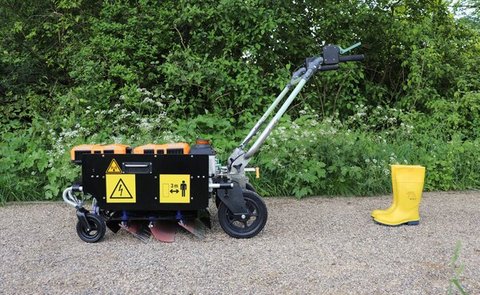Treating Weeds in Hard Surfaces and Soil with Electricity
Different electric weeding technology works in different ways. Here's a breakdown of what works well where and why.
We have several new electric weeding products available from Kersten and Zasso. These machines all use electricity to kill weeds, but the systems differ markedly in their uses. Here are the important distinguishing reasons to use one over another.
Surface Conductivity and Electric Weeding
All materials are conductive, however, some are more conductive than others, and some provide more resistance than others. In order to overcome different levels of resistance we need different voltages.
Damp soil is a relatively good conductor of electricity, which requires less voltage in order to overcome the resistance. In this instance somewhere between 3000 and 6000 volts is optimal for a good connection. On hard surfaces a larger voltage is required to make a good connection, due to the higher resistance in the surfaces. Our products for hard surfaces usually use around 10,000 volts.

The Zap weeder - ideal for use on hard surfaces
Root depth in different surfaces
In soil, plant roots will generally be deeper, the distance between electrodes matters.
The Kersten Electric weedkiller places the two electrodes at a large distance apart - usually between 10-20 meters. This enables the electricity to make a larger loop and go deeper into the ground, killing plants with deeper root systems.
Converseley, the zap weeder from zasso has a shorter distance between electrodes, meaning the effect is shallower, but allowing a much more portable machine. Plants on hard surfaces such as pavements tend to have much shallower roots, whilst plants more commonly found in deeper soil - such as Japanese knotweed require deeper root treatment.
Varying the voltage to suit the plant
Shallow rooted plants do not need a long application of electricity in order to boil the cells in the heart of the plant. Therefore a high voltage can get the job done quickly.
Plants with deeper roots need more time for the heat to reach the extremities of the plant. At high voltage, the device can burn through the plant before enough heat has built up in the roots below. To counter this, the voltage can be lowered, in order to deliver a longer shock to the plant without damaging the upper part of the plant too quickly. (slicing through the plant stem).

Kersten Electric Weed Killer - with variable voltage for effective treatment of plants in soil - Treating Japanese Knotweed
With the correct tools and the correct settings, it is very easy to have a systemic effect on the plant, killing it more effectively than other types of thermal treatment.
For more information on our Electric Weeding Tools click here!
No comments yet. Login to start a new discussion Start a new discussion